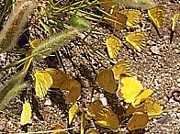
C. Munill Insects, spiders, centipedes, and millipedes are members of the phylum Arthropoda. Over one million species have been described worldwide, but scientists estimate that the true number of living species may be in the tens of millions. Arthropods possess a hard exoskeleton of chitin which they must shed in order to grow, and jointed appendages and segmented bodies with various patterns of segment fusion. There are only two spiders in the United States which can be deadly to humans. The black widow is black with a round shiny abdomen bearing a bright red hourglass on the underside. The brown recluse is brown with a lighter violin pattern on the back. Both are small (1/2 inch or less) but immediately recognizable. Because of their secretive nature, very few people are bitten by these spiders. 
B. Michel, NPS Contrary to popular belief, tarantulas are not deadly to humans and are actually quite calm, biting only when provoked. Tarantulas do possess barbed hairs which they may rub off their bodies with their legs. The hairs cause irritation to the skin and eyes and are used as a defense mechanism. The most likely time to see a tarantula in Mojave is in the fall, when mature males are in search of a mate. Tarantula Hawk Tarantulas are parasitized by another arthropod, the tarantula hawk (Pepsis sp.) Actually a wasp, the tarantula hawk stings a tarantula to paralyze it and then lays its egg on the body of the spider. When the wasp larvae hatches it feeds on the spider.
Insects Approximately 90,000 species of insects have been described in the United States and Canada alone. Insects have three body segments (head, thorax, and abdomen) and six legs. Most modern insects are winged as adults, including such commonly encountered creatures as flies, dragonflies, beetles, butterflies, moths, bees, wasps, grasshoppers, crickets, termites and cicadas. Ants are a conspicuous exception to this trend, as most ants are wingless (only the queen and male ants have wings). Pronuba Moth One of the more interesting insects of the Mojave is the pronuba moth (Tegeticula sp.) The female pronuba moth lays her eggs in the ovary of a yucca (Yucca sp.) flower which she has pollinated. The moth larvae feed on the developing seeds of the yucca but leave some to mature. Most species of yucca could not reproduce were it not for the assistance of the pronuba moth, as it is the only insect to pollinate the yucca flowers. The arrangement between yucca and moth is an example of mutualism, so called because both plant and animal benefit from the relationship. |
Last updated: March 29, 2020
